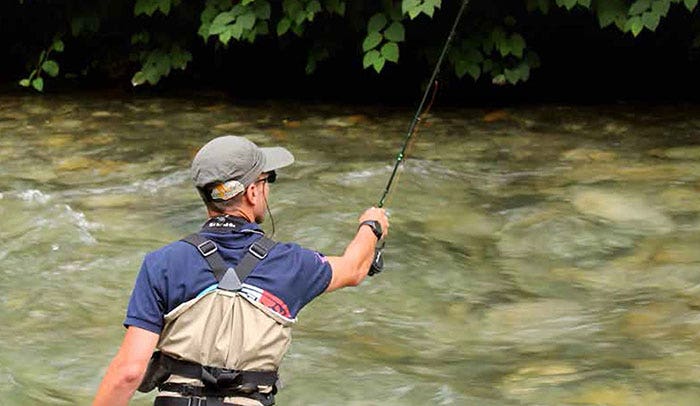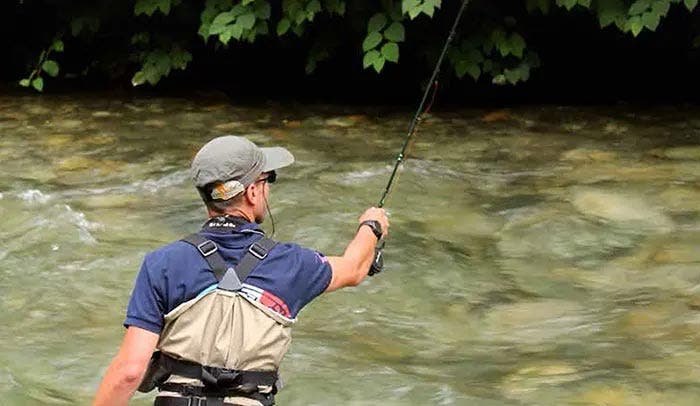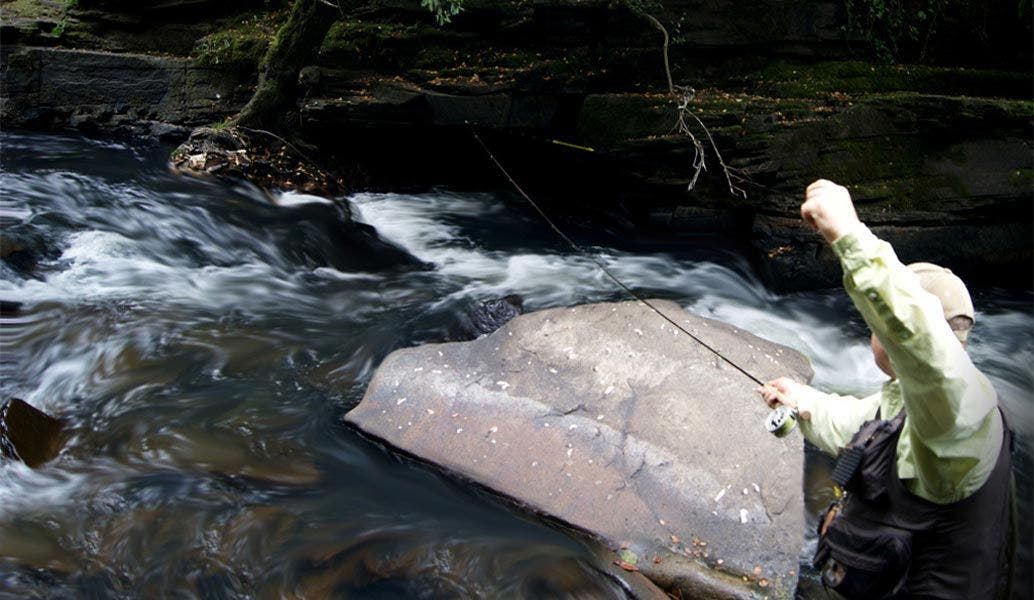When you’re out on the river fishing for trout in the height of summer, or grayling through the winter, almost everyone you bump into these days is fishing a French leader – a devastatingly effective method that has been favoured by many top competition anglers for quite a few years now.
French leader fly fishing was first developed and mastered by French and Belgian anglers, who dominated competition fly fishing for a long time and as the other teams caught wind of the technique they, quite naturally, started to experiment with similar set ups.
So it is that for at least ten years now, anglers from all over Europe have adopted the French leader technique and it is now the ‘go-to’ nymphing style and, in my eyes, it's taking over from Czech Nymphing.
What is French Nymphing?
French Nymphing is a style of fishing that was created to catch spooky fish in very shallow, slow flowing rivers, but over time it has been adapted to fish fast water of up to a meter or so deep - the method many of us know it as today. However, the French leader is extremely versatile and can be adapted to fish all types of running water.The French leader comprises an extremely long, tapered monofilament leader. The taper is made up of a steep but gradual taper, designed to be fished on long and soft fly rods. At the end of the tapered leader there’s a short indicator piece, generally a length of coloured nylon or braid approximately 6-10 inches long. From the indicator you have your tippet and flies. You should vary the length of your tippet to the depth of water you’re fishing, i.e. 3 feet deep = 3 foot tippet.
The important thing to remember when using a French leader is to flick or lob the flies, rather than cast – you very rarely use a fly line when fishing this method, unless you’re fishing extremely long distances.
The advantage of using a French leader is that you can present your flies with absolutely zero drag, at range. The majority of French leader set ups are designed to be fished between 2 and 9 meters away from the angler, making this the perfect method to target pressured fish.
Nymphing - The New Way from Jonathan White on Vimeo.
Equipment for French Nymphing
Choosing the correct rod for the river you’re fishing is essential. The rod length is generally chosen for the size of the river, and the rod weight determined by the size of the fish and flies intended to be used. The 3# Greys GR70 Streamflex is a tried and tested French leader rod, the length and softness makes casting light flies on the long leader easier than ever before.A long-tapered leader is the preferred set up for French nymphing, with the RIO Euro Nymph Leader (3.4m long) a firm favourite of mine – it comes ready with a built-in indicator piece, which is considered the heart and soul of the French leader. The indicator provides the angler with vital information, any movement away from its natural position shows the fly has been intercepted by a fish and taken, or it has hit a snag – any movement should be met with a small flick or strike of the rod to potentially set the hook. A yellow or orange indicator is easily seen against the foliage, but white, blue or even black may stand out better in some circumstances – bi-colour indicators are also very effective.
Extremely fine tippets are commonly used when French nymphing, these fine leaders allow your flies to sink quickly through fast water and are less likely to spook fish, especially on waters that are heavily fished. I tend to use Fulling Mill World Class Fluorocarbon of 2-5lb breaking strain depending on the water height and clarity. When the fishing is tough and you need your flies to be presented flawlessly, monofilament tippets such as Stroft or Fulling Mill Xtra Co-polymer are invaluable.
Fishing the French Leader Technique
The biggest difference in using the French leader to any other ‘conventional’ river method is the lack of fly line… This can sometimes be a struggle when you first start fishing the technique, but persistence is key and you will quickly master the flicking/casting technique to get the lengthy tapered leader to travel. The key is to start short and gradually work towards lengthening your cast.The French leader is always cast upstream into the current, above any potentially likely looking lies. Once cast, lift your arm, and the rod, high in the air so that the tapered leader and indicator are above the surface of the water, keeping everything consistently taut, without dragging the flies back towards you. Lead and track the indicator with your rod along with the current whilst the flies fish and sink through the water column for as long as possible. At the end of the cast, lift the flies gently out of the water, cast and repeat the process throughout the length of the pool. Remember to strike at any movement to the indicator!

What Flies to Use?
Tungsten-beaded flies are essential to fishing the French leader to its full potential. Flies tied on jig hooks are favoured as the weight is offset over the eye of the hook, allowing the fly to fish ‘point up’, away from the bottom and lowering the chance of hooking up – jigs generally allow the flies to fish for a longer period of time before having to be recast. Other patterns such as Czech Nymphs and straight hooked patterns do, however, work extremely well.My Top 5 recommended flies for French Nymphing
- Depth Charge Flash Back Pheasant Tail
- Depth Charge Orange Hot Spot Pheasant Tail Jig
- Flashback Tungsten Pheasant Tail Nymph
- HVK Leadhead Hare's Ear
- Depth Charge Shrimp Pink
Now Find Out More at Our Nymphing Open Day!
If you would like to find out more about French nymphing then visit the Sportfish Game Fishing Centre, Reading from 2pm on Saturday 8th October where Jonathan White and Oscar Boatfield will be launching their new book ‘Nymphing, The New Way’ as well as giving talks and demonstrations on all aspects of french nymphing including: fly tying, leader preparation, tackle and techniques.[vc_button title="Save the Date and Join Our Facebook Event »" target="_blank" color="default" size="size_large" href="https://www.facebook.com/events/650935715075926/"]
Two-time individual winner of the International Rivers Championship, Kieron Jenkins, talks us through the ins and outs of the increasingly-popular French Nymphing technique and selects his top tackle and flies to use for the method.
When you’re out on the river fishing for trout in the height of summer, or grayling through the winter, almost everyone you bump into these days is fishing a French leader – a devastatingly effective method that has been favoured by many top competition anglers for quite a few years now.
French leader fly fishing was first developed and mastered by French and Belgian anglers, who dominated competition fly fishing for a long time and as the other teams caught wind of the technique they, quite naturally, started to experiment with similar set ups.
So it is that for at least ten years now, anglers from all over Europe have adopted the French leader technique and it is now the ‘go-to’ nymphing style and, in my eyes, it's taking over from Czech Nymphing.
What is French Nymphing?
French Nymphing is a style of fly fishing that was created to catch spooky fish in very shallow, slow flowing rivers, but over time it has been adapted to fish fast water of up to a meter or so deep - the method many of us know it as today. However, the French leader is extremely versatile and can be adapted to fish all types of running water.
The French leader comprises an extremely long, tapered monofilament leader. The taper is made up of a steep but gradual taper, designed to be fished on long and soft fly rods. At the end of the tapered leader there’s a short indicator piece, generally a length of coloured nylon or braid approximately 6-10 inches long. From the indicator you have your tippet and flies. You should vary the length of your tippet to the depth of water you’re fishing, i.e. 3 feet deep = 3 foot tippet.
The important thing to remember when using a French leader is to flick or lob the flies, rather than cast – you very rarely use a fly line when fishing this method, unless you’re fishing extremely long distances.
The advantage of using a French leader is that you can present your flies with absolutely zero drag, at range. The majority of French leader set ups are designed to be fished between 2 and 9 meters away from the angler, making this the perfect method to target pressured fish.
Equipment for French Nymphing
Choosing the correct rod for the river you’re fishing is essential. The rod length is generally chosen for the size of the river, and the rod weight determined by the size of the fish and flies intended to be used. The 3# Greys Wing Streamflex is a tried and tested French leader rod, the length and softness makes casting light flies on the long leader easier than ever before.
A long-tapered leader is the preferred set up for French nymphing, with the RIO Euro Nymph Leader (3.4m long) a firm favourite of mine – it comes ready with a built-in indicator piece, which is considered the heart and soul of the French leader. The indicator provides the angler with vital information, any movement away from its natural position shows the fly has been intercepted by a fish and taken, or it has hit a snag – any movement should be met with a small flick or strike of the rod to potentially set the hook. A yellow or orange indicator is easily seen against the foliage, but white, blue or even black may stand out better in some circumstances – bi-colour indicators are also very effective.
Extremely fine tippets are commonly used when French nymphing, these fine leaders allow your flies to sink quickly through fast water and are less likely to spook fish, especially on waters that are heavily fished. I tend to use Fulling Mill World Class Fluorocarbon of 2-5lb breaking strain depending on the water height and clarity. When the fishing is tough and you need your flies to be presented flawlessly, monofilament tippets such as Stroft or Fulling Mill Xtra Co-polymer are invaluable.
Fishing the French Leader Technique
The biggest difference in using the French leader to any other ‘conventional’ river method is the lack of fly line… This can sometimes be a struggle when you first start fishing the technique, but persistence is key and you will quickly master the flicking/casting technique to get the lengthy tapered leader to travel. The key is to start short and gradually work towards lengthening your cast.
The French leader is always cast upstream into the current, above any potentially likely looking lies. Once cast, lift your arm, and the rod, high in the air so that the tapered leader and indicator are above the surface of the water, keeping everything consistently taut, without dragging the flies back towards you. Lead and track the indicator with your rod along with the current whilst the flies fish and sink through the water column for as long as possible. At the end of the cast, lift the flies gently out of the water, cast and repeat the process throughout the length of the pool. Remember to strike at any movement to the indicator!




What Flies to Use?
Tungsten-beaded flies are essential to fishing the French leader to its full potential. Flies tied on jig hooks are favoured as the weight is offset over the eye of the hook, allowing the fly to fish ‘point up’, away from the bottom and lowering the chance of hooking up – jigs generally allow the flies to fish for a longer period of time before having to be recast. Other patterns such as Czech Nymphs and straight hooked patterns do, however, work extremely well.
My Top 5 recommended flies for French Nymphing
- Depth Charge Flash Back Pheasant Tail
- Depth Charge Orange Hot Spot Pheasant Tail Jig
- Flashback Tungsten Pheasant Tail Nymph
- HVK Leadhead Hare's Ear
- Depth Charge Shrimp Pink
If you enjoyed our French Nymphing guide… please leave your comments below – it’s great to share & chat! You can also share with all your friends via our social sharing buttons.


